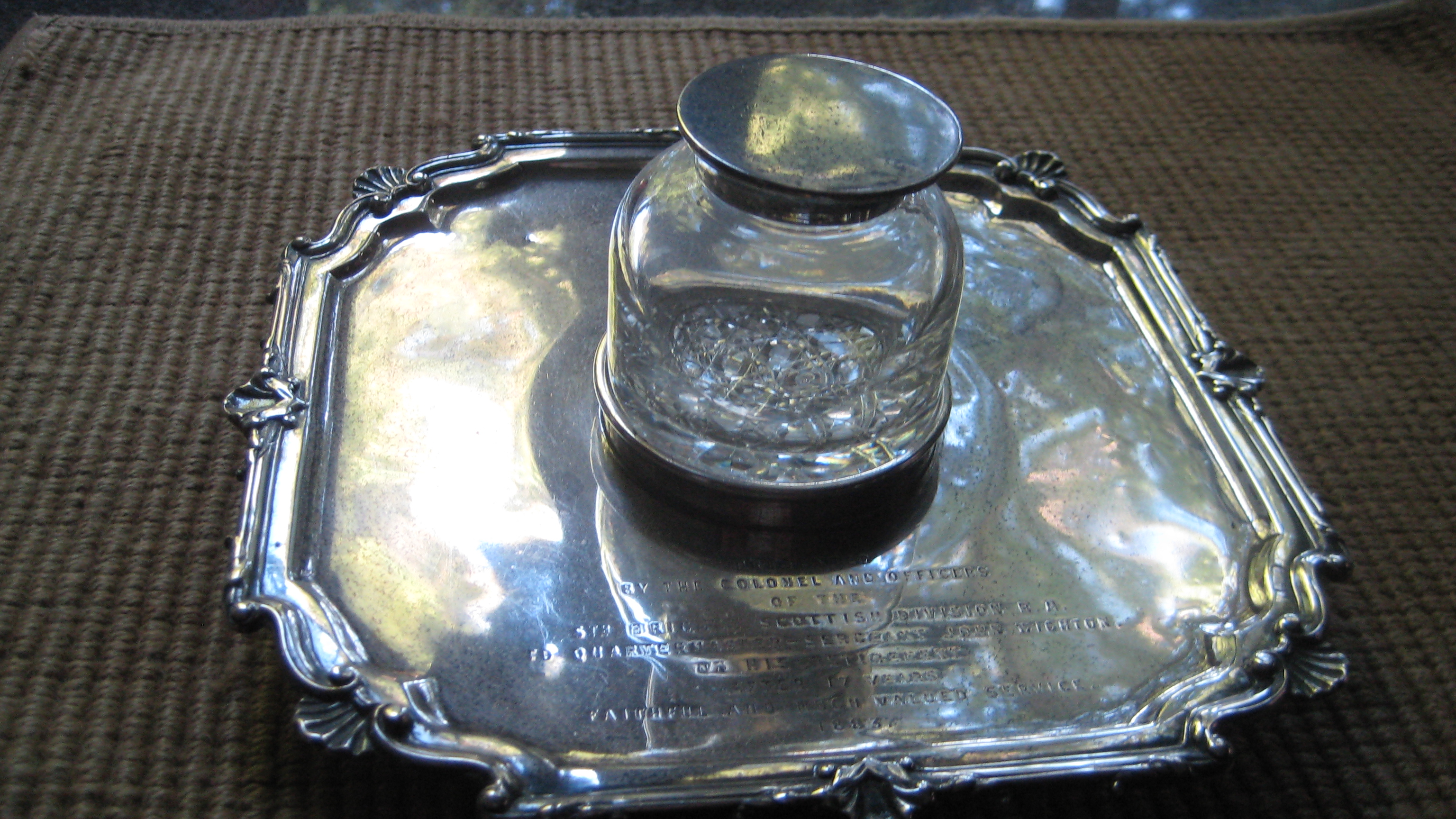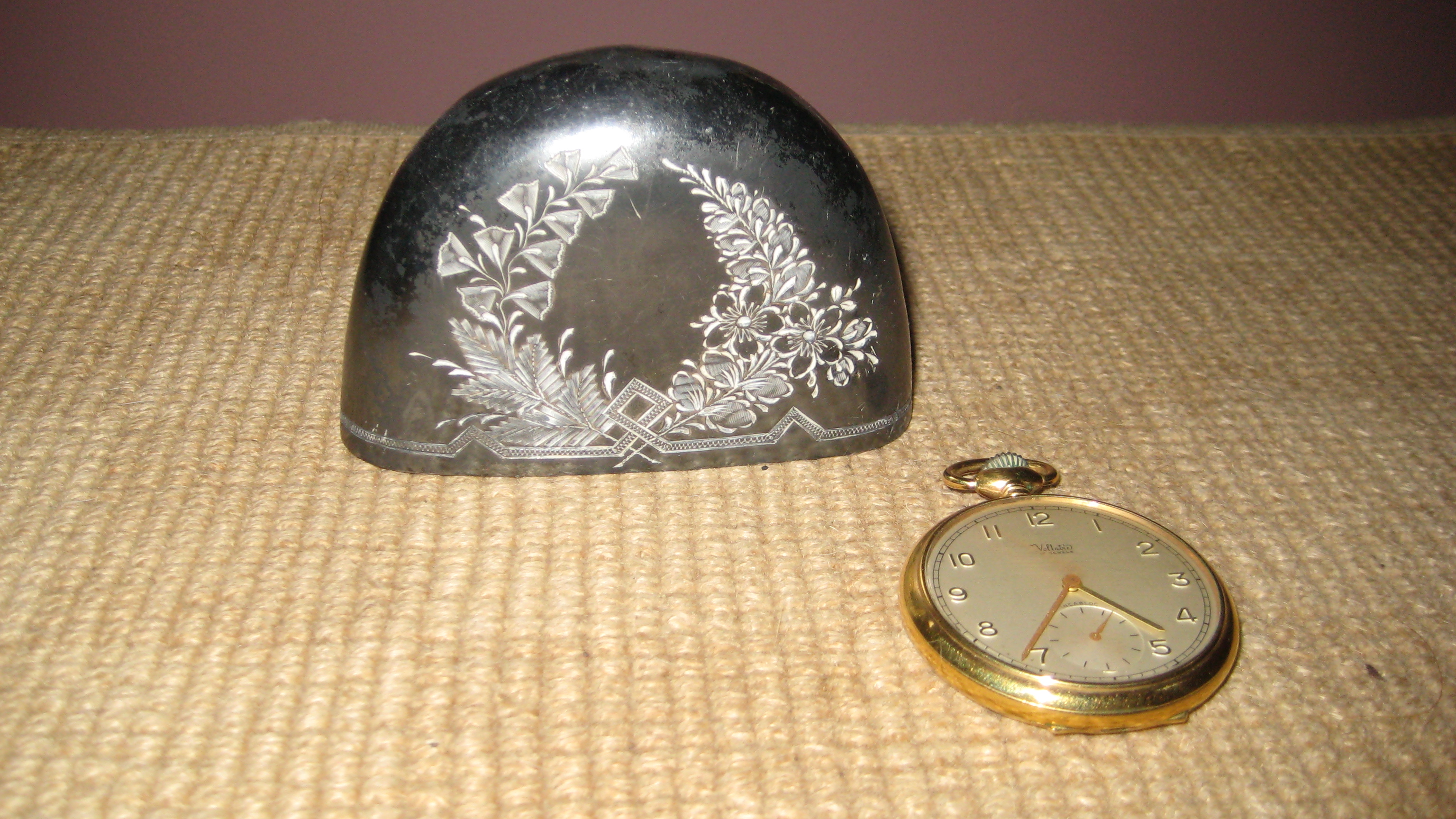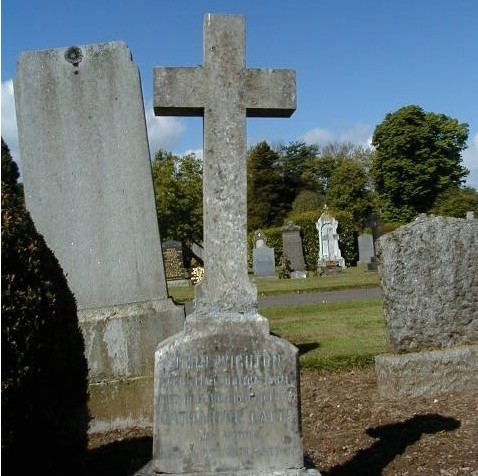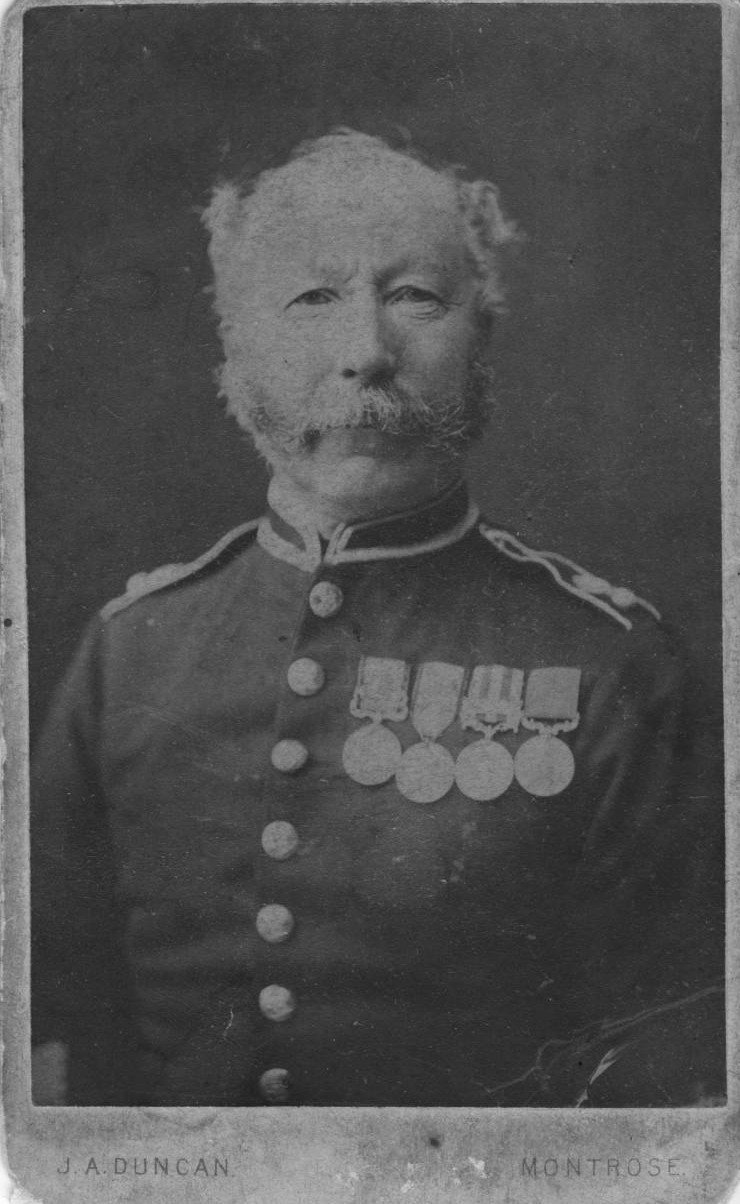John (Baxter)'s infancy
John Baxter Wighton was born in Alyth on January 16, 1823. Baptized on January 23, he was named after his father (John - the manager of a shoe and boot factory in Alyth) and his mother (Ann Baxter). At some point before 1826, John's mother and father moved to Dundee where they lived for the rest of their lives. John's four sisters were born in Dundee.
Life in Scotland when JBW was growing up
As you may have already read in the Early Wightons website, Dundee in the early 19th century was not a healthy place to live. In the biography of JBW's father (John Wighton), I showed you pictures of the area around 174 Overgate area where they lived. However, those pictures were taken in the 1900s, and the Overgate certainly was not like that between 1825 and 1850 when JBW was growing up. Health and sanitation conditions in the city were deplorable. JBW was fortunate just to get past infancy. Howff Cemetery records reveal that 22 Wighton children died before they reached the age of 2 during this period. Reasons included water in the head, chincough (whooping cough) and even teething. However, surviving infancy was no guarantee of long life. Children still died before the age of 10, for example of inflammation related causes. And, if you survived your youth, death was still common in young adulthood. For example, there was a Mary Wighton living in Dundee who died at the age of 23 from consumption.
While deplorable living conditions were prevalent, the Industrial Revolution also meant that Dundee enjoyed a booming economy. Work was plentiful and young children were routinely employed in the factories. John almost certainly would have been put to work as a young boy and the pennies he earned would have gone into the family's earnings. With JBW's grandfather being a stone mason and his father being a shoe-maker, we should not be surprised to find that JBW entered a trade. By the time he was 20, he was working as a Brass Founder - a worker who casts brass. (Source: JBW's army records)
Dundee, Scotland, and Britain as a whole were at the beginning of a remarkably stable period when JBW was growing up. After the Battle of Waterloo in 1815, the Western World entered a period known as Pax Britannica. Britain had emerged as the dominant military force after the Napoleonic wars - in part, because the European nations were splintered and weak. The British navy controlled all of the world's oceans and seas - and that meant that Britain controlled all the key naval trade routes. As a result, Britain was able to dominate overseas markets and British imperialism expanded aggressively. Domestically, this period meant that profits gained from the overseas British Empire, as well as from industrial improvements at home, allowed a large, educated middle class to develop. JBW's parents probably benefited as did John's sisters.
John participated in Pax Britannica in a different way - as a member of the British armed forces which applied Britain's power as required. British armed forces protected its colonial interests through garrisons at key ports (e.g., Halifax). Through its control of the seas, it could move its troops quickly to quell uprisings (e.g., Indian mutiny) or to slap down any country challenging its supremacy (e.g., Crimea war). As you'll read, JBW participated in all of these examples of British displays of power.
1843-1851: JBW's early military career
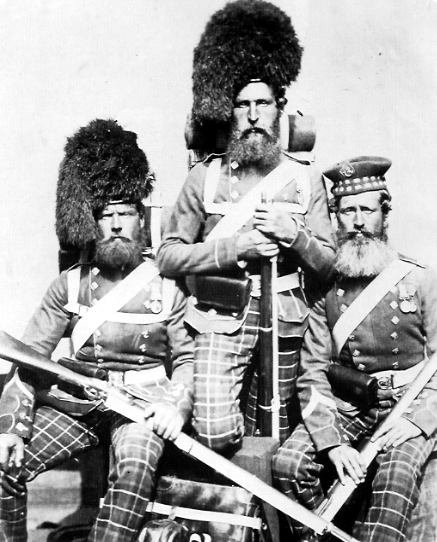
Three members of the 72nd Highlanders Regiment, circa 1855.)
On August 11th, 1843 (at the age of 20 years and 7 months) John enlisted in the 72nd Highlanders. (The War Office records say that he enlisted at 17 years, 10 months; however, that age does not jive with any of the other birth information that we have.) John enlisted in the regiment at Dundee and was given the service number 1758. At the time of enlistment, he was 5 ft., 7 inches tall with fresh complexion, gray eyes and dark brown hair.
You could say that John's decision to enlist in the army was prompted by his family. Amy Louisa (Hutcheon) Wighton (JBW's daughter-in-law) recounted the following story in a letter to her grandchildren, John Wighton and Ella Peterson. [Ann Baxter Wighton's] younger brother did nothing but lay about and enjoy an easy life and talk about his nephew John Wighton as he was a growing boy. Till at last John Wighton went and enlisted in the army to get rid of his none too welcome uncle.
For the next 8 years, John traveled the world as part of the 72nd Highlanders (formerly the Seaforth Highlanders). The 72nd was a foot regiment, that is they were foot soldiers or infantry. Included with the regiment would be artillery units.
From 1843 to 1853, the regiment served as follows:
- 1843: At the time of John's enlistment, the 72nd was stationed in Ireland. In August, they were stationed at Templemore (County of Tipperary), but marched (100 km.) from there to Fermoy (Country of Cork) in September. Both of these bases were in the south-central area of what is now the Republic of Ireland.
- 1844: In July, the regiment left Fermoy, stayed in Buttevant, and from there marched to Cork arriving September 28th. Under the command of Lieutenant Colonel Lord Arthur Lennox, the regiment left Cork November 27, 1844 on the troop-ship Resistance and arrived in Gibraltar December 12th. John would remain in Gibraltar for 3+ years. In 1847, at the age of 24, and after only four years of service, John was given a double promotion from the rank of Private to the rank of Sergeant. This seems rather unusual to me, especially given that the promotion was not earned during a time of war, but rather while the regiment was on garrison duty.
- 1848: On February 15th, the regiment embarked for the Barbadoes under the command of Lieutenant-Colonel Gascoyne on board the transport ship Bombay. They arrived on March 14, 1848. From 1848 to 1851, the regiment served in Barbados, Trinidad, St. Lucia, Demerara, Grenada, and Tobago.
Sergeant Wighton, as he was now known, was soon to find his life changed. In May 1851, the 72nd Highlanders were posted to Canada where they would remain for 3+ years. Their first two months (July and August, 1851) were spent in Halifax and then the regiment was transferred to Fredericton where they stayed from September 1851 to some time in 1853. They returned to Halifax in 1853 and left Canada in 1854. For further information, you may wish to read about the British Military in Halifax and the British Military in Fredericton
1853: John weds Catherine Latta
At some point during his approximate 3 year duty in Canada, John met Catherine Latta. The exact date of that meeting is unclear. Amy Louisa (Hutcheon) Wighton says that he met her while he was stationed in Halifax. According to the historical record of the regiment's deployment, that would have given him only July and August in 1851 to meet her. Catherine had an uncle who lived in Halifax and she might have been staying with him at that time. The regiment then shifted to Fredericton. In November of that same year, the 1851 census records 17 year old Catherine living in Fredericton. Did she follow him from Halifax? Or was she already living there and just visiting Halifax? Or, did ALHW make a mistake about where they met?
No matter when and where they met, John and Catherine were married on March 28, 1853 at St. Anne's Chapel in Fredericton NB. There is some confusion about Catherine's age when she married, but I'll discuss that in her biography.
According to the information we received from the army's Public Record Office, John's rank in 1853 was Sergeant. However, Catherine and John's marriage certificate clearly identifies John as a Colour Sergeant of the 72nd stationed in Fredericton. The rank of Colour Sergeant is a significant step up from the rank of Sergeant and it is inconceivable that this entry would have been made if it were not true. John's marriage to Catherine would have required approval from a ranking officer in the regiment, and members of the regiment would have been in attendance. Having the position of a Staff Sergeant in the regiment would have helped John obtain the necessary permission to have Catherine travel with the regiment and I suspect that they would not have married if she did not have a way to accompany him when the regiment left North America. (It's possible that the British army did not make a distinction in their records between a sergeant and a colour sergeant.)
1854: The couple's first child, Ann Wighton
To learn more about John and Catherine's first child, we have to work backwards. The 1971 report conducted for John Wighton and Ella Peterson by the Scots Ancestry Research Society revealed that an Ann Wighton had died on February 16th, 1855 at Overgate, Dundee. She was 12 months old at the time, had lived in Dundee for two months, and had been born in North America to parents John Wighton, soldier, and Catherine Latta. The information for the death entry was provided by the child's grandfather, John Wighton. She was buried in Old Howff Cemetery, Dundee.
This leads us to assume that Ann was conceived in Fredericton in April 1853 and born February, 1854, most probably in Fredericton. We know that John's regiment left Canada (in October?) and arrived in Limerick, Ireland on October 24, 1854. We can probably assume that Ann travelled with John. The regiment was slated to be transferred to Malta soon afterwards, and given Ann's young age (6 months), it appears likely that John and Catherine decided that it would be better for Catherine and Ann to stay in Dundee with John's parents. Catherine would have travelled from Ireland to Dundee, perhaps arriving in December, 1854. This means that they would have been living in Dundee for two months as the death records report.
1854-1856: The Crimean War
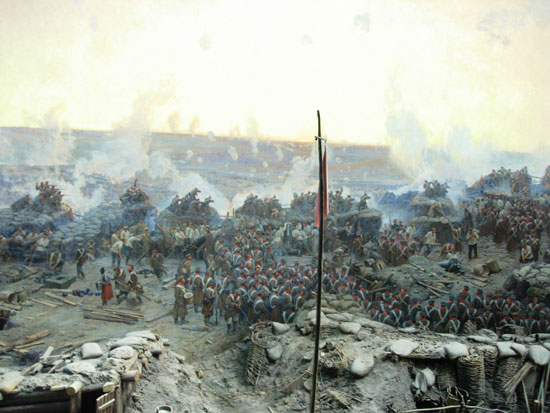
Russian fortifications, Sebastopol, 1855
The 72nd left Cork, Ireland on December 14, 1854 for Malta, where it remained until May 22, 1855 when it left in the Alma steamer for the Crimea War, arriving near Balaklava on May 29th. In all, John was in the Crimea for 14 months. He received two Crimea medals - one issued by the British government and the other issued by the Sultan of Turkey.
I found a report on the Medical and Surgical History of the British Army which served in Turkey and Crimea during the war against Russia in the years 1854, 1855, and 1856 that was delivered to the British Parliament in their 1857/58 session. The health of each regiment was described in some detail by the medical staff. The 72nd Highlanders were described on pages 368-373 of that report. I have excerpted the pertinent parts in a somewhat lengthy essay titled Medical History of the 72nd Regiment in the Crimea. You should find this interesting reading since you'll get some insight into John's life during that period. Included in the essay is a description of the most dangerous part of John's service during his 14 months in the Crimea.
1857: The couple's second child, John Murray Wighton
Back home in Scotland, Catherine gave birth to John Murray Wighton on November 16, 1857 in Dundee. The registrant of the birth was a Mr. Alexander Lees, uncle to the infant, and occupant of the house where the child was born. (JBW's sister, Barbara Baxter Wighton, married Alexander Lees in 1850.) This suggests that Catherine stayed with the Lees before and after the birth. If so, young John Murray would have had plenty of company with three cousins born before him and four more to be born after him. According to the 1861 census, the Lees lived at 61 Brown Street. Google map reveals that this was within easy walking distance of grandparents John Wighton and Ann Baxter's home in the Overgate.
Of course, the curious among you may ask how young John Murray Wighton came to be our Generation 6 forebear when John Baxter Wighton was in the Crimea. So, here's what happened to JBW after his regiment was no longer needed in the Crimea. The 72nd left the Crimea in the early part of July 1856. They arrived at Portsmouth on the 30th of the month, and from there went to Aldershot, a town in the English county of Hampshire, located on heathland about 60 km southwest of London. (Around the time of the Crimea War, military officials saw the need for a standing army and the land around Aldershot was chosen as its site. Today, Aldershot is known as the Home of the British Army. ) In August 1856, the 72nd took up quarters in Guernsey, one of the Channel Islands and remained there until April 1857. Catherine was obviously given permission to join JBW in Guernsey and it's probable that she was with JBW for most of the time that the 72nd was stationed there. (John Murray Wighton would have been conceived somewhere around February, 1857.) The 72nd regiment returned to England and was barracked at Shorncliff from April 1857 to September 1857. In September of 1857, two months before John Murray was born, the 72nd embarked from Portsmouth for India.
1858-1865: Service in India, Harry, and retirement from the regular army
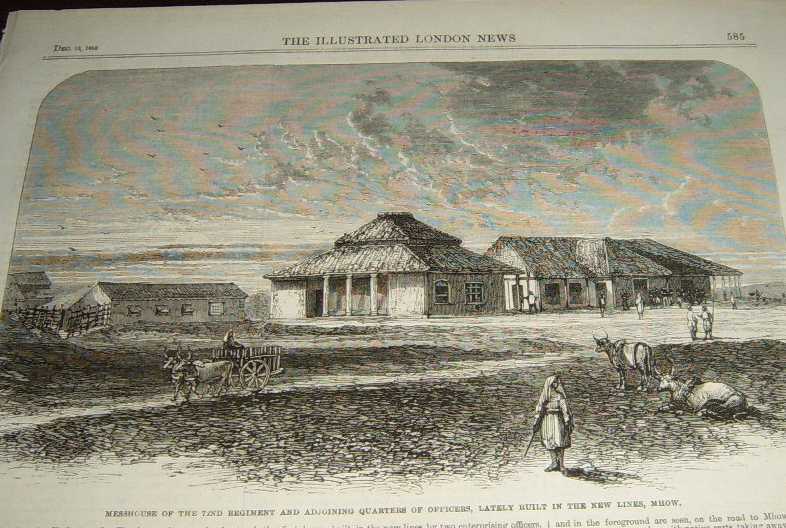
Messhouse of the 72nd regiment and the adjoining officers' quarters, Mhow, 1863
The 72nd arrived in Bombay in January of 1858 and joined the British Forces embroiled in the Sepoy Mutiny, a.k.a. the Indian Rebellion, the Sepoy Rebellion. I have three essays for you to read on this event. This first (The Sepoy Mutiny) will give you an overview of the causes of the rebellion. In the last stages of the rebellion, the action was focused on what was known as the Central India Campaign and it is here that John Wighton spent the first part of his duty. My second essay (The Central India Campaign from a Soldier's Perspective) will offer you an insight into what the soldiers faced in that campaign. At the end of the campaign, John was awarded the India Mutiny Medal with a clasp for Central India.
By 1859, the battles were over and the regiment returned to Britain's main army depot at Mhow in Central India and remained there to 1860. Mhow is an acronym and stands for Military Headquarters of War. See the image above for what the countryside and the army installations looked like around Mhow in 1863. Mhow is now a military establishment for the Indian government.
From what I can determine, many of the 72nd's postings were in three year intervals (1844-47 Gibraltar, 1848-51 West Indies, 1851-54 Canada). If that pattern was not coincidental, then 1860 would have been the end of the 72nd Regiment's tour. That may have been the reason why, in 1860, John transferred from the 72nd Highlanders to the 3rd Bombay Infantry Regiment - a unit of the Honorable East India Company that was part of the Central India Task Force in which John served from 1858-1859. (His service number in his new regiment was 1248.) At about this time, the British government was taking over the colonial government and the East India Company would soon disappear. All of its army units would be taken over by the British Army. (In 1861, the 3rd Bombay Infantry became the 109th Bombay Infantry Regiment.)
While the 72nd would remain in Mhow in Central India, John travelled to Simla in the Himalaya hills of Northern India where his new unit was posted. Simla was another major army post which Britain had acquired in 1816 at the end of the Anglo-Nepalese war. For soldiers, it was an attractive posting because of its cooler climate and absence of risk of malarial infection. (Simla would later become the summer site of the Indian government.) We know John was in Simla because his third child Harry is buried there. Harry died in infancy. (We have neither Harry's date of birth nor his date of death. We may safely conclude that Catherine and young John Murray Wighton had travelled from England to join her husband at some point during his posting. (John would ultimately spend 7 years and two months in his posting in India.)
In 1861, John was promoted to the position of Sergeant Major. As the most senior enlisted person in the regiment, a Sergeant Major has an unusual amount of authority in the British Army. He is responsible for the training and discipline of all enlisted men and NCOs in their regiment/company and reports directly to the second-in-command. It is worth emphasizing that John Baxter Wighton achieved the highest possible rank in the British Army that was open to him and he served in that capacity for four years. Sergeant Major Wighton returned to England with Catherine in 1865 and was discharged from the Regular Army on May 9th, 1865 at the age of 42. He received a medal for Long Service and Good Conduct on his retirement. During his 21 years, 191 days of service, John Baxter Wighton was never wounded. His character was assessed as Most exemplary.
1865-1883: Fanny and service with the 5th Brigade in Montrose
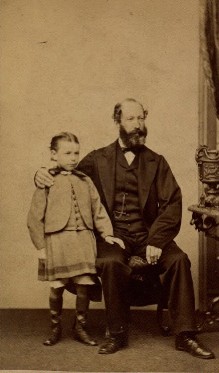
John Baxter Wighton (seated) and John Murray Wighton, circa 1865
The above picture is the earliest picture we have of a Wighton family member. From information on the back of the photo, we learn that it was taken by James Gibb, a photographer in Dundee. Handwriting on the back identifies the two people as John Wighton, Senior, John Wighton, Junior, after leaving India. We don't know exactly when the picture was taken. From John's service record, we know that he served in India for 7 years and 2 months. If his tenure in India was taken from the 72nd's arrival in India (January, 1858), this would mean that he left India in March 1865. If his service in India was taken from when the 72nd left England (September 1857), he would have left India in January 1865. According to his service record again, John was discharged on May 9th, 1865. It's possible that the picture in Dundee was taken in the interval after he arrived in England and before being discharged (Jan-May?), for example, if he was given a leave. If so, would he be in civilian clothes? Or, more likely, the picture was taken after his discharge, approximately May, 1865. Either way, that puts John Baxter Wighton's age at 42 years old, and John Murray Wighton's age at about 7 and 1/2 years old.
Note JBW's long established beard and moustache in the photo. One would think that this would be uncomfortable in the heat of India. However, there's a story behind this that cousin Margaret found. Soldiers picked up the habit of growing mustaches in the early 19th century while living in India because the facial hair conferred status. The colonial mustache became so prevalent, in fact, that by the middle of the century when John was stationed there, British officers serving in the East India Co.'s forces were required to grow them. We may speculate that this prestige was extended to staff sargeants as well.
We may speculate that just as John joined the army because of family pressures, so did he also resign. John and Catherine's fourth child, Fanny, was born in March of 1865 in Shorncliff, England where the army had a barracks. It's possible that still distressed by the death of Harry in India, John and Catherine wanted to have their fourth child in England.
Although John may have left the regular army, he did not leave military life entirely. According to his service record, he served a further 17 years (from 1866 to 1883) as Quarter Master Sergeant on Permanent Staff of the 5th Brigade Scottish Divisional Artillery, a Volunteer Unit. In 1866, this unit was known as the 105th Militia, Forfar and Kinkardine Artillery and was headquartered in Montrose. The unit was renamed the 5th Brigade in 1882 and the headquarters were moved to Dundee. The position of Quarter Master Sergeant is one of some importance in a regiment. My research into this rank revealed some information which provides fodder for some interesting speculation about John's duties in the 72nd Regiment. To learn more, read the essay Was John Baxter Wighton the original Q? (Q was the quartermaster who provided James Bond with all of his gadgets.)
I have been unable to find much information on this militia unit. The Land Forces web site notes its existence but not much more. I did learn that Britain has had a long history of reliance on volunteer units to support its regular army - the "militia" being the most established form of that support. In the 1850's, almost every militia regiment was mobilized for home defence in order to release the whole Regular Army for action in the Crimea and India. The available information suggests that John's 105th Militia was a group of volunteer, part-time soldiers who were providing home defense during this period.
In the April 2, 1871 census, John and his family were reported living in Montrose. John was shown as 46 (real age = 48), Catherine as 37, John as 13, and Fanny as 6. This record was difficult to find because the family surname is recorded as Wigton. Their address is difficult to determine, but it's probable that they lived on India Street and there were at least 5 families living in the same building as them. India Street still exists in Montrose.
While John may have been on "permanent" staff, that does not mean that he was employed full-time. Amy Louisa (Hutcheon) Wighton made reference to her father-in-law working as a "factor for some of the estates in Angus and Perthshire. This is confirmed by John's burial plot information which gives his occupation as House Factor. (A factor is an estate manager.) According to ALHW, A farmer named Wighton got very friendly with Grandfather Wighton when he was factor for some of the estates in Angus and Perthshire. They tried to trace back to see if they were of the same stock and they were really very like each other. Some 140 years later, I pursued the search for a link between the two John Wightons. You can read what I found and what I have speculated in the story of The Mystery of the Unknown John Wighton
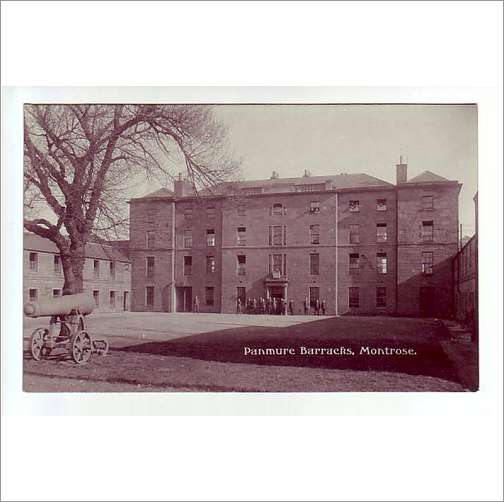
Our next confirmed sighting of the Wighton family was provided by the April 1881 census. John (age shown as 57), Catherine (age 46) and Fanny (age 16) were living in the Panmure Barracks in Montrose. The building in the picture (foreground above) is the Panmure Barracks with other housing shown next to it. Web research revealed that other members of the Forfar and Kincardine Artillery used Panmure Barracks as their mailing address so it appears that permanent staff attached to the militia were housed in this building (and perhaps in other buildings in the same area.) It's possible that John and Catherine's residence in 1871 (India Street) was the Panmure Barracks as well. I was unable to get a street address for the Barracks. For information on where they lived, read the essay on History of Montrose.
1883 - 1890: Retirement
